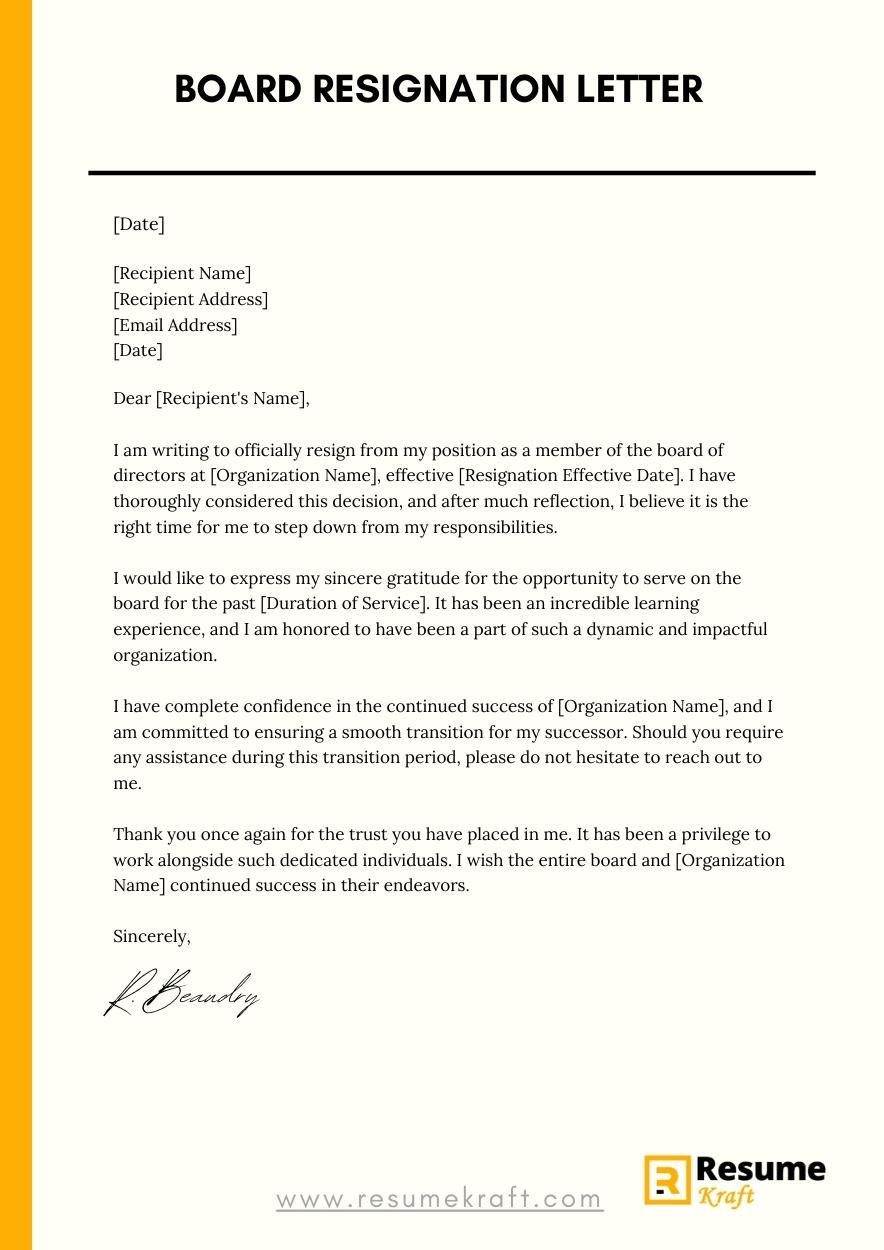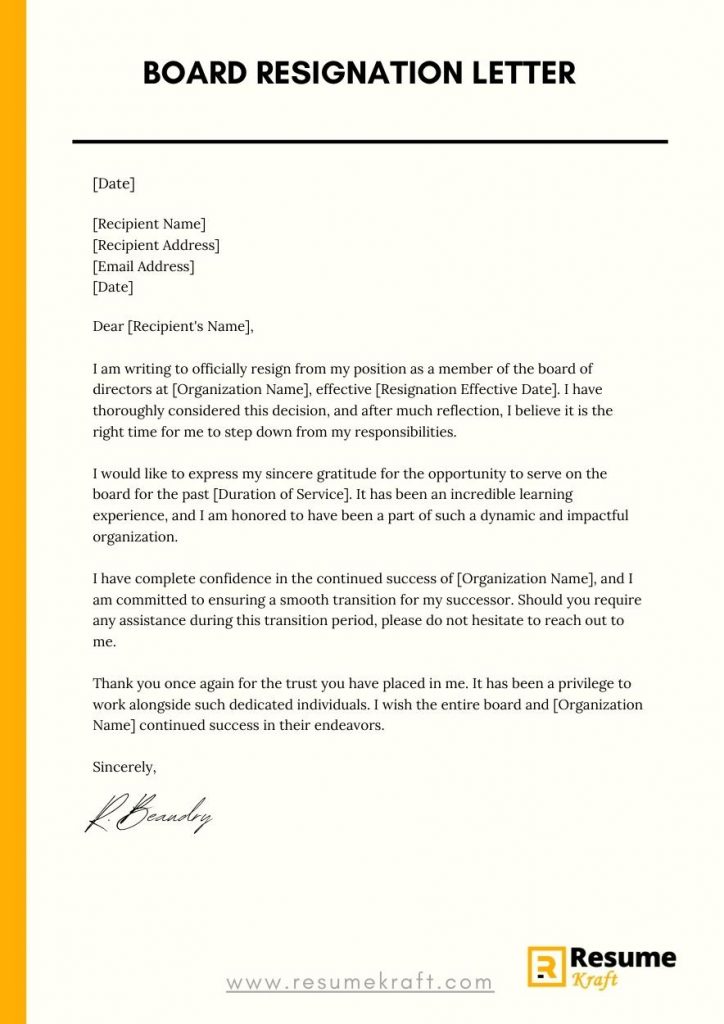
Are you a board member seeking to resign from your position? Learn how to write a compelling and professional board resignation letter in this ultimate guide. Find step-by-step instructions, formatting tips, and sample letters to help you craft the perfect resignation letter.
The board of directors plays a crucial role in shaping the direction and strategy of an organization. However, there may come a time when a board member needs to step down due to various reasons. In such cases, it is essential to communicate the decision formally through a board resignation letter. This comprehensive guide will walk you through the process of writing an effective and professional board resignation letter. From what to include and what not to include, to formatting tips and sample letters, we’ve got you covered.
What to Include in a Board Resignation Letter
A well-written board resignation letter should include the following components:
- Date: Start the letter by mentioning the date of writing.
- Recipient: Address the letter to the appropriate person or entity, such as the board chairman or the entire board of directors.
- Salutation: Begin the letter with a formal salutation, such as “Dear Board of Directors” or “Dear Chairman [Last Name].”
- Statement of Resignation: Clearly state your intention to resign from your position on the board.
- Reason for Resignation (Optional): If you feel comfortable, briefly explain the reason behind your decision to resign. However, it is not mandatory to disclose the details.
- Appreciation: Express your gratitude for the opportunity to serve on the board and highlight any valuable experiences or lessons gained.
- Transition Plan (Optional): If possible, offer assistance in transitioning your responsibilities to a new board member or provide suggestions for a smooth transition.
- Resignation Effective Date: Specify the date when your resignation will be effective. It is important to provide reasonable notice to allow for succession planning.
- Contact Information: Include your contact details, such as your phone number and email address, so that the board can reach out to you if needed.
- Closing: End the letter with a formal closing, such as “Sincerely” or “Best Regards,” followed by your name and signature.
What Not to Include in Your Board Resignation Letter
While it is important to be professional and courteous in your board resignation letter, there are certain things you should avoid including:
- Negative Remarks or Criticisms: Avoid making negative comments or criticisms about the board, organization, or fellow board members. Keep the tone positive and constructive.
- Personal Grievances: Do not use the resignation letter as a platform to air personal grievances or settle disputes. Keep the focus on your decision to step down.
- Overly Lengthy Explanations: Be concise and to the point. Avoid going into excessive detail about your reasons for resigning.
- Sensitive Confidential Information: Refrain from disclosing sensitive or confidential information about the organization or its stakeholders.
How to Format a Board Resignation Letter
Formatting your board resignation letter properly is essential to maintain a professional appearance. Here are a few tips to consider:
- Font and Typeface: Use a professional font, such as Arial or Times New Roman, and ensure that the text is easily readable. Keep the font size between 10 and 12 points.
- Alignment and Spacing: Align the text to the left, and use single spacing throughout the letter. Leave a line space between paragraphs for clarity.
- Letterhead (Optional): If you are resigning from a high-profile position, using a letterhead with your name and contact information can add a touch of professionalism.
- Length: A board resignation letter should typically be kept to one page.
- Proofreading: Before sending the letter, carefully proofread it for any grammatical errors or typos. Double-check that all the necessary details are included and accurate.
Board Resignation Letter Samples
To help you get started, here are two sample resignation letters: one in a printed format and another for sending via email.

Printed Resignation Letter Sample
[Your Name]
[Your Address]
[City, State, ZIP Code]
[Email Address]
[Phone Number]
[Date]
[Recipient’s Name]
[Recipient’s Position]
[Organization Name]
[Organization Address]
[City, State, ZIP Code]
Dear [Recipient’s Name],
I am writing to officially resign from my position as a member of the board of directors at [Organization Name], effective [Resignation Effective Date]. I have thoroughly considered this decision, and after much reflection, I believe it is the right time for me to step down from my responsibilities.
I would like to express my sincere gratitude for the opportunity to serve on the board for the past [Duration of Service]. It has been an incredible learning experience, and I am honored to have been a part of such a dynamic and impactful organization.
I have complete confidence in the continued success of [Organization Name], and I am committed to ensuring a smooth transition for my successor. Should you require any assistance during this transition period, please do not hesitate to reach out to me.
Thank you once again for the trust you have placed in me. It has been a privilege to work alongside such dedicated individuals. I wish the entire board and [Organization Name] continued success in their endeavors.
Sincerely,
[Your Name]
[Signature]
Email Resignation Letter Example
Subject: Board Resignation – [Your Name]
Dear [Recipient’s Name],
I hope this email finds you well.
I am writing to inform you of my decision to resign from my position as a member of the board of directors at [Organization Name], effective [Resignation Effective Date]. Please consider this email as my formal resignation from the board.
I would like to take this opportunity to express my deepest appreciation for the experiences and growth I have gained while serving on the board. I am grateful for the trust and support that the board and [Organization Name] have given me during my tenure.
As I make this transition, I am committed to ensuring a seamless handover of my responsibilities. If there is any assistance I can provide or if you require further information, please feel free to reach out to me via email or phone.
Once again, thank you for the valuable opportunities and memories. I wish the board and [Organization Name] continued success in all future endeavors.
Best Regards,
[Your Name]
Key Takeaways:
- Writing a well-crafted board resignation letter is crucial when stepping down from a board position.
- Include essential components like the date, recipient, statement of resignation, appreciation, and effective date of resignation.
- Avoid negative remarks, personal grievances, and disclosing sensitive information in the resignation letter.
- Formatting is important for a professional appearance, including font, alignment, spacing, and length.
- Proofread the letter thoroughly before sending it to ensure accuracy and professionalism.
Frequently Asked Questions
Q1: What is the purpose of a board resignation letter?
A1: A board resignation letter serves as a formal notification of a board member’s intention to step down from their position. It provides an opportunity to express gratitude, offer assistance in transitioning responsibilities, and ensure a smooth transition for the organization.
Q2: How much notice should be given in a board resignation letter?
A2: It is customary to provide reasonable notice when resigning from a board position. Generally, a notice period of 30 to 60 days is considered appropriate to allow for succession planning and facilitate a smooth transition.
Q3: Should I include a reason for resigning in my board resignation letter?
A3: While it is not mandatory, you may choose to include a brief and professional reason for your resignation. However, it is important to exercise discretion and avoid negative comments or criticisms.
Q4: Can a board member resign immediately?
A4: In certain circumstances, such as personal emergencies or conflicts, a board member may need to resign immediately. However, it is generally recommended to provide a reasonable notice period to ensure an orderly transition.
Q5: Is it necessary to sign a board resignation letter?
A5: Yes, it is customary and professional to physically sign a printed board resignation letter. In the case of an email resignation letter, you may include a digital signature or simply type your name after the closing.
Conclusion
Writing a board resignation letter may seem daunting, but with the right guidance and approach, it can be a respectful and professional way to communicate your decision. Remember to be concise, positive, and appreciative in your letter. By following the tips and samples provided in this ultimate guide, you can craft an effective board resignation letter that maintains relationships and paves the way for a smooth transition.

